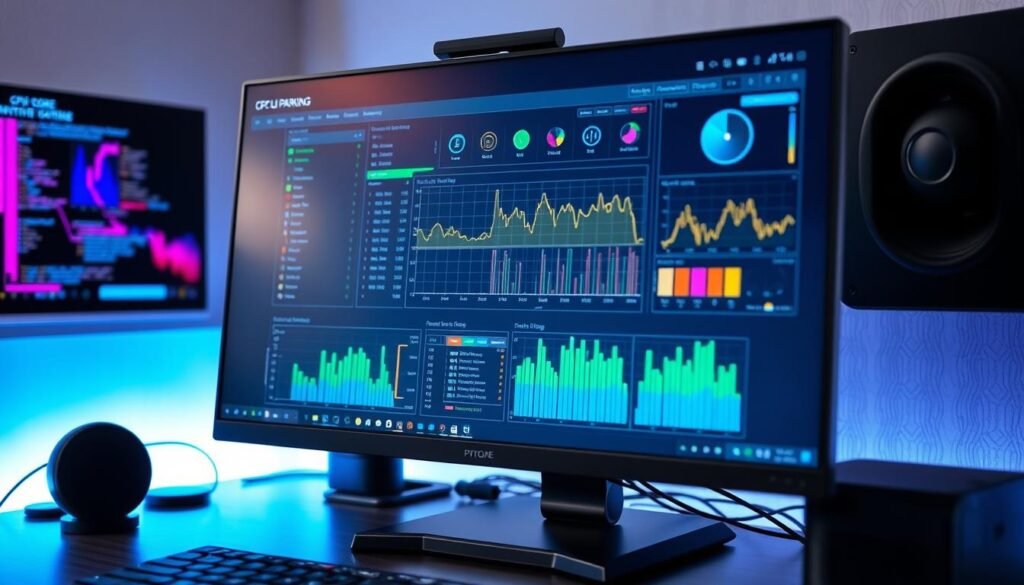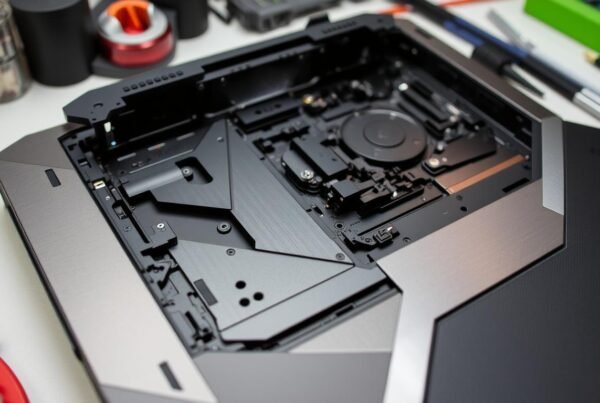Did you know over 50% of modern Windows 10 users don’t know about CPU core parking? This feature helps save power and can boost performance for heavy tasks. It’s key for gamers, content creators, and anyone wanting to get the most from their PC.
Contents
Key Takeaways
- CPU core parking is a power-saving feature that can impact system performance
- Checking the status of core parking is important for optimizing your PC’s capabilities
- Disabling core parking can improve performance in high-demand scenarios
- Monitoring core parking settings is crucial for managing system temperature and power consumption
- Understanding the trade-offs between performance and power efficiency is key to finding the right balance
In this quick guide, we’ll show you how to see if CPU core parking is on for your Windows 10. We’ll also share tips on how to use it for better performance. This info is great for anyone wanting to get the most out of their PC.
Understanding CPU Core Parking and Its Purpose
CPU core parking is a power-saving feature in modern processors. It helps save energy by putting idle CPU cores to sleep. This is key for laptops and mobile devices to extend battery life.
What Makes Core Parking Important
Core parking is vital for managing power in today’s computers. As processors get more powerful, they use more energy and heat up. By sleeping idle cores, it balances power use and performance. This is great for devices that run on battery for long periods.
How Core Parking Affects System Performance
Core parking saves power but can slow down your system. When a core wakes up, it takes time, causing delays and slower responses. This is a problem for tasks that need quick CPU access, like gaming or video editing.
Benefits and Drawbacks of Core Parking
The main advantage of CPU core parking is saving power and cooling systems. But, it can slow down your system in some cases. If you need fast performance, you might turn off core parking to use more power and stay cooler.
| Benefits of CPU Core Parking | Drawbacks of CPU Core Parking |
|---|---|
|
|
The effect of CPU core parking on performance depends on your needs and tasks. Finding the right balance between saving power and performance is key to optimizing your system.
How to Check if CPU Core Parking is Enabled
It’s important to check if CPU core parking is on your Windows system. This is key for better system performance. Whether you’re into gaming, heavy computing, or just want your computer to run smoothly, knowing about core parking helps a lot. Luckily, there are a few ways to see if CPU core parking is turned on on your Windows device.
Using Windows Task Manager
Checking CPU core parking status is easy with the Windows Task Manager. Here’s how:
- Open the Task Manager by pressing Ctrl+Shift+Esc or by right-clicking on the taskbar and choosing “Task Manager”.
- Go to the “Performance” tab.
- Look for cores that say “Parked”. This means core parking is on for your system.
Utilizing Third-Party Tools
There are also third-party tools that give a detailed look at your CPU’s core parking. These tools are easy to use and let you see each core’s status. Some top picks are ParkControl and Lasso.
| Tool | Key Features |
|---|---|
| ParkControl | – Shows the current core parking status – Lets you turn core parking on or off with one click – Has advanced options for tweaking core parking settings |
| Lasso | – Gives a full view of CPU core use and parking – Helps manage power settings and boost performance – Works with many processors, including the newest Intel and AMD ones |
Using these tools, you can learn more about your system’s core parking setup. This knowledge helps you improve your system’s performance.

Keeping an eye on your CPU’s core parking and adjusting it when needed can really improve your system. It affects performance, power use, and heat management. Whether you use Windows Task Manager or a third-party tool, knowing how to manage core parking is a useful skill for any Windows user.
Methods to Control Core Parking in Windows
Understanding CPU core parking in Windows can be tricky. But knowing how to manage it can help improve your system’s performance. Let’s look at three main ways to control core parking in Windows.
Using Power Options Settings
The Power Options in Windows make it easy to manage core parking. By setting ‘Minimum processor state’ to 100% in the ‘Processor power management’ section, you can stop core parking. This keeps all CPU cores active, even when they’re not busy. It’s a simple way to control core parking.
Registry Editor Method
If you’re okay with using the Windows Registry, you can get more control. Go to HKEY_LOCAL_MACHINE\SYSTEM\CurrentControlSet\Control\Power\PowerSettings\54533251-82be-4824-96c1-47b60b740d00\0cc5b647-c1df-4637-891a-dec35c318583 and change the ‘ValueMax’ to 0. This disables core parking completely.
Group Policy Editor Approach
Windows 10 Pro and Enterprise users can use the Group Policy Editor for more control. Go to ‘Computer Configuration > Administrative Templates > System’ and find ‘Processor power management’. Here, you can set up different core parking and processor power management settings.
Each method gives you different levels of control, depending on your technical skills. Knowing these options helps you customize your Windows system. You can adjust cpu core parking registry, power options, processor power management, and windows settings to meet your needs and improve performance.
“Disabling CPU core parking in Windows can significantly enhance system performance, particularly during high-demand tasks.”
| Method | Level of Control | Technical Expertise Required |
|---|---|---|
| Power Options Settings | Basic | Low |
| Registry Editor | Advanced | Moderate |
| Group Policy Editor | Comprehensive | High |
Impact of Core Parking on System Performance
Understanding CPU resource management is key to system performance. Core parking in modern operating systems can have both good and bad effects. It depends on what you need and how you use your computer.
For tasks like video editing, 3D rendering, or scientific simulations, turning off core parking helps. It makes tasks finish faster and your computer run smoother. This is because all CPU cores are used, spreading out the work better.
But, turning off core parking also means using more power and possibly getting hotter CPUs. This might worry users who care about resource monitor cpu utilization and keeping their computer running long. The impact on performance can change a lot, depending on your tasks and computer setup.
| Scenario | Core Parking Enabled | Core Parking Disabled |
|---|---|---|
| Video Rendering | Slower task completion | Faster task completion |
| 3D Modeling | Choppy performance | Smoother performance |
| Web Browsing | Adequate performance | Marginal improvement |
Choosing whether to use core parking should be based on knowing your work and computer well. You might need to try different settings to find the best balance. This balance is between how fast your computer runs, how much power it uses, and how hot it gets.
“Optimizing CPU core utilization is a delicate balancing act, requiring users to weigh the benefits of performance against the tradeoffs of power efficiency.”
Common Issues and Troubleshooting Core Parking Settings
Disabling CPU core parking can boost performance. Yet, users might face some common problems. One big issue is when Windows turns it back on to save power and cool down the CPU. This can mess with how well the CPU works, especially when it tries to use Turbo Boost.
Dealing with Automatic Core Parking
Users often need to check if core parking is on and change settings if it is. Tools like ParkControl make it easy to keep an eye on and control core parking. This helps keep the system running smoothly.
Resolving Performance Inconsistencies
Without core parking, systems might feel slow or have sudden delays. This happens because of how power, heat, and CPU use interact. To fix this, users should watch system performance closely. They should tweak settings for high cpu usage, core parking utility, and processor power management as needed.
Managing Temperature and Power Usage
Turning off CPU core parking means the CPU works harder and gets hotter. It also uses more power. It’s crucial to have good cooling, like fans and heatsinks, to handle the extra heat. Also, keeping an eye on temperatures and adjusting power settings can help balance performance and power use.









